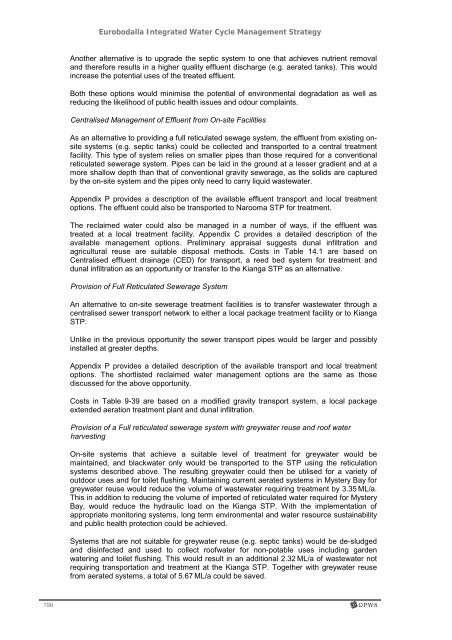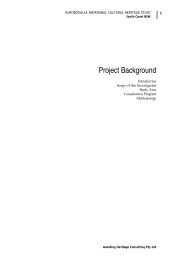Eurobodalla Integrated Water Cycle Management Strategy
Eurobodalla Integrated Water Cycle Management Strategy
Eurobodalla Integrated Water Cycle Management Strategy
Create successful ePaper yourself
Turn your PDF publications into a flip-book with our unique Google optimized e-Paper software.
196<br />
<strong>Eurobodalla</strong> <strong>Integrated</strong> <strong>Water</strong> <strong>Cycle</strong> <strong>Management</strong> <strong>Strategy</strong><br />
Another alternative is to upgrade the septic system to one that achieves nutrient removal<br />
and therefore results in a higher quality effluent discharge (e.g. aerated tanks). This would<br />
increase the potential uses of the treated effluent.<br />
Both these options would minimise the potential of environmental degradation as well as<br />
reducing the likelihood of public health issues and odour complaints.<br />
Centralised <strong>Management</strong> of Effluent from On-site Facilities<br />
As an alternative to providing a full reticulated sewage system, the effluent from existing onsite<br />
systems (e.g. septic tanks) could be collected and transported to a central treatment<br />
facility. This type of system relies on smaller pipes than those required for a conventional<br />
reticulated sewerage system. Pipes can be laid in the ground at a lesser gradient and at a<br />
more shallow depth than that of conventional gravity sewerage, as the solids are captured<br />
by the on-site system and the pipes only need to carry liquid wastewater.<br />
Appendix P provides a description of the available effluent transport and local treatment<br />
options. The effluent could also be transported to Narooma STP for treatment.<br />
The reclaimed water could also be managed in a number of ways, if the effluent was<br />
treated at a local treatment facility. Appendix C provides a detailed description of the<br />
available management options. Preliminary appraisal suggests dunal infiltration and<br />
agricultural reuse are suitable disposal methods. Costs in Table 14.1 are based on<br />
Centralised effluent drainage (CED) for transport, a reed bed system for treatment and<br />
dunal infiltration as an opportunity or transfer to the Kianga STP as an alternative.<br />
Provision of Full Reticulated Sewerage System<br />
An alternative to on-site sewerage treatment facilities is to transfer wastewater through a<br />
centralised sewer transport network to either a local package treatment facility or to Kianga<br />
STP.<br />
Unlike in the previous opportunity the sewer transport pipes would be larger and possibly<br />
installed at greater depths.<br />
Appendix P provides a detailed description of the available transport and local treatment<br />
options. The shortlisted reclaimed water management options are the same as those<br />
discussed for the above opportunity.<br />
Costs in Table 9-39 are based on a modified gravity transport system, a local package<br />
extended aeration treatment plant and dunal infiltration.<br />
Provision of a Full reticulated sewerage system with greywater reuse and roof water<br />
harvesting<br />
On-site systems that achieve a suitable level of treatment for greywater would be<br />
maintained, and blackwater only would be transported to the STP using the reticulation<br />
systems described above. The resulting greywater could then be utilised for a variety of<br />
outdoor uses and for toilet flushing. Maintaining current aerated systems in Mystery Bay for<br />
greywater reuse would reduce the volume of wastewater requiring treatment by 3.35 ML/a.<br />
This in addition to reducing the volume of imported of reticulated water required for Mystery<br />
Bay, would reduce the hydraulic load on the Kianga STP. With the implementation of<br />
appropriate monitoring systems, long term environmental and water resource sustainability<br />
and public health protection could be achieved.<br />
Systems that are not suitable for greywater reuse (e.g. septic tanks) would be de-sludged<br />
and disinfected and used to collect roofwater for non-potable uses including garden<br />
watering and toilet flushing. This would result in an additional 2.32 ML/a of wastewater not<br />
requiring transportation and treatment at the Kianga STP. Together with greywater reuse<br />
from aerated systems, a total of 5.67 ML/a could be saved.

















